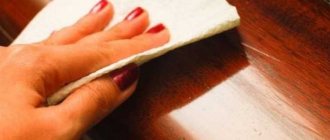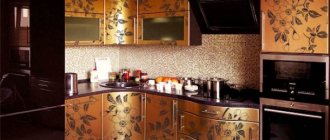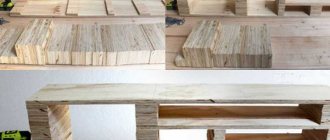39994
Wooden furniture in the house is an indicator of the good taste of the owners and concern for their own health. Wood is an environmentally friendly natural material, absolutely safe for humans. In order for wooden interior items to look attractive longer and not accumulate dust, it is necessary to properly care for them. A tool that helps achieve this is polish. To ensure that taking care of wooden furniture does not harm the health of your household, it is better to prepare furniture polish with your own hands. Since many products for this purpose, located on store shelves, contain harmful substances.
With ammonia
It is perfect for kitchen furniture, for example, a countertop, and will also not spoil the bar drain and painted surfaces. You will not only get rid of dust, but also protect the furniture from possible contamination in the future, or more precisely, from the penetration of dirt into microcracks in the wood. Ammonia does not leave cloudy traces, providing maximum shine to the surface. Due to its accessibility, it is enough to mix the solution with water, wipe the contaminated surface, and pour what is left into something and hide it out of the reach of children until next time. The solution will have good cleaning properties even after a long time. Do not forget that to use this product, it is necessary to ventilate the room, because ammonia has an unpleasant odor.
Kinds
Companies that produce household chemicals for the care of wooden furniture offer a wide range. When purchasing a polish, it is important to consider the type of surface (varnished base or without a glossy finish). The worse the condition of the furniture, the denser the composition should be in order to polish, fill scratches with the mixture, and refresh the shade of the wood. It is necessary to clarify what types of surfaces can be applied to the selected type of polishing agent: some names are suitable for processing various types of material.
READ ALSO: Silicone cases
With wax
The compositions are used to treat furniture that has microdamages. It is very difficult to hide large scratches, but wax polishes do an excellent job with minor problems on the surface. Sprays are not suitable; a thick emulsion is needed. Synthetic waxes are just as effective, but are more affordable, have a more convenient consistency, and provide the perfect gloss.
From dust
Many polishes contain an antistatic substance that prevents microparticles from settling on the surface for several days. An excellent effect is obtained by spraying sprays and applying thick emulsions. Despite the low concentration of antistatic components, the compositions allow longer protection of the treated surface from the accumulation of static electricity.
Risk from modern chemical cleaning products
These include:
- allergies - human skin is very sensitive to chemicals and if you buy a professional detergent, the manufacturer will definitely indicate on the label that special gloves are needed;
- aggressiveness - not every furniture is suitable for one or another cleaning product. The surface may simply fade or the varnish may fade altogether. Always read what kind of furniture the solution is suitable for;
- harmful - technology does not stand still and now it is enough to have a can of cleaning aerosol and a dry cloth. But the spray can enter the respiratory system. The label may indicate that the substance does not pose any danger, but it is better to use an ordinary medical mask and ventilate the room.
Regardless of what detergents you use: based on natural ingredients or purchased ready-made, always ventilate the room. Do not forget that the substance evaporates and enters the air, which can cause health problems.
DIY furniture polish
Wood furniture requires constant care to maintain its natural beauty and shine. We can buy a lot of products in stores, but they are all filled with chemical components that are harmful to health and also cost a lot.
So why don’t you try making your own polish at home, it’s very simple. By preparing a natural furniture polish, you will save money. Plus, you'll have complete peace of mind that you're not inhaling harmful chemicals while caring for your home.
Polish with ammonia
Ingredients : ammonia – 2 tsp, warm water – 1 l.
Mix 2 tsp. ammonia with warm water. This product will clean painted surfaces and countertops very well. Place this solution in a fine spray bottle. Shake the bottle before use.
Vinegar polish
Ingredients : vinegar – 2 tsp, warm water – 1 l.
Dissolve vinegar in water. This solution is well suited for most varnished and painted surfaces. Use as you would a regular polish.
Olive oil and lemon polish
Ingredients : olive oil – 1 cup, lemon juice (vinegar) – 1/4 cup.
Mix olive oil and lemon juice (or vinegar). Pour the mixture into a container with spray. Shake the polish thoroughly before each use. Spray the polish onto a rag, spread it over the furniture and rub with another dry cloth until it shines. The shelf life of this polish is unlimited.
*An oil-based polish is only suitable for wood that is not coated with varnish.
Wax based polish
Ingredients : wax – 2 tbsp, olive oil – 1 glass, lemon essential oil – 1/2 tsp.
Melt the wax in a water bath, add olive oil. Finally, pour in the essential oil, stir, and cover with a lid. When the mixture has cooled, you can use it. Rub the mixture with a cotton cloth onto clean furniture.
Polish based on Vaseline and wax
Ingredients : crushed wax - 1/4 cup, vaseline (linseed) oil - 3/4 cup, essential oils - 1 tsp.
Heat the wax in a steam bath, add oil and pour essential oil into the slightly cooled mixture.
Apply to furniture, rubbing well, then buff with a clean cotton cloth.
*Use this polish only on unvarnished wooden furniture.
Let your furniture please you with its beauty for a long time!
5 / 5 ( 5 votes)
Review of popular tools
The difference between polishes is not only in cost: the main thing is the composition and consistency of the products. You can consult with relatives and colleagues and find out what type of polish they recommend. Useful information about popular furniture care products will help you evaluate the benefits of each item.
Cinderella
Russian-made polish is suitable for caring for various types of furniture. The composition is used for processing not only wooden coatings, but also marble, plastic, ceramics, enamel, and other types of base materials.
Luxury
The spray is produced by a German company. Excellent effect when caring for painted, polished and unpainted furniture. No pungent odor, no streaks after treatment. Luxus spray quickly removes fingerprints, insects, dust, and minor dirt. The composition contains antistatic and water-repellent components. The spray is suitable for different types and shades of wood.
Anti-dust
A popular remedy from Russian manufacturers. Good dust-repellent effect, reasonable cost, maximum comfort during use. Regular use of antistatic agents allows you to maintain order without hassle. In addition to repelling dust, the composition gives wood and other surfaces a pleasant shine.
Pronto
The most famous type of household chemicals for caring for wooden surfaces. offers housewives several lines of polishes with different effects. The mixture of waxes ensures the elimination of minor scratches, removal of dust, a pleasant shine, and the furniture looks almost like new. A pleasant aroma is a characteristic feature of this brand. Housewives can purchase a spray and a thick emulsion. Pronto polish is suitable for improving the appearance of various types of surfaces: from wood to marble and ceramic.
Chirton
A pleasant aroma, a high-quality mixture of waxes, an excellent antistatic effect, removal of various types of contaminants and dust, creation of the thinnest water-repellent layer - these are the advantages of Chirton brand compositions. Regular use allows you to preserve the structure of the material even with a significant period of use of the furniture.
READ ALSO: How to choose a smartphone
Sanding the varnish
Polishing furniture is a long process and it begins with sanding. First, all cracks and other defects are covered with wood putty of a suitable color. After it has completely dried (the period is indicated on the label), sanding begins.
A sander is best for polishing wood or veneer. Tape or disk is a matter of taste and preference; it also depends on the complexity of the furniture shape. You will also need a set of sandpaper from coarse (80) to very fine (1200) grit.
In extreme cases, an angle grinder with a special attachment (disc and Velcro) may be suitable. But when working with it, it is difficult to achieve a really good result - there is no required mobility of the sanding platform, so the result of such wood polishing will not be above average.
What you might need to varnish furniture
We start sanding with 80 grit. We use it carefully, removing only large irregularities. Then we repeat the treatment with sandpaper at 120, then at 180 and 240. During the work, we must periodically remove dust and inspect the surface to identify unevenness and other defects. sometimes they are better identified by touch.
Then take water and 320 grit sandpaper. Wet the surface to be sanded and the sandpaper. We sand everything again, but this time with water. At this stage, you should get a good result - everything should be smooth. If everything is satisfactory, we move on; if not, we polish it for some more time.
The process is the same as during preparation, only we use sandpapers with a finer grain - starting from 400. Be sure to sand with water - moisten the surface and sandpaper. Having finished processing, we attach sandpaper with 600 grain, then with 1000 and 1200.
This stage is the last one before actual polishing. After this treatment, the surface should be absolutely flat, uniform, without defects.
Applying varnish
Let's talk about which varnishes are best to use. The best are considered alkyd (Tikkurila Unika-super series), polyurethane and water-polymer (good ones are Swedish Bask).
Despite the lack of odor, water-based varnish is not the best choice for your first varnishing experience. Essentially it is a water-based suspension. But it is far from being as harmless as is commonly believed. Water-based varnishes contain very harmful solvents, albeit in small quantities.
This is by the way, but the reason is essentially different - difficulties during processing. When applying varnish, water is absorbed into the wood fibers and they rise. As a result, after the first treatment, the surface is far from smooth, but very rough. This effect is especially pronounced on pine products. So after the first layer of water-based varnish has dried, take an angle grinder or a sander, attach 320-grit sandpaper to it and sand it until smooth.
How to apply varnish
Now a little about how to apply varnish. Professionals believe that the best method is spraying from a spray gun. This may be true, but not all home craftsmen have such a device, and you also need to be able to work with a spray gun. Among manual application methods, a popular method is application with a piece of foam rubber (or a new kitchen sponge) or a fabric swab (soft, white, lint-free fabric). To decide, you need to try what is more convenient for you, how it turns out smoother (if it works out at all).
The next method is with a small foam roller. Suitable if you are varnishing a surface of a simple shape without small details (a door leaf, for example).
Applying varnish with a brush is the most unpopular method
The use of brushes when varnishing furniture, oddly enough, is in last place. The fact is that it is difficult to evenly apply a layer of varnish in this way. You need a good brush with soft, thick, natural bristles, which should not tangle under any circumstances.
Technology
Regardless of the chosen method of applying varnish, its layers should be thin and of uniform thickness. Take a little product onto a brush/sponge/roller/tampon and rub it over the surface as thoroughly as possible. Next time we dip it in varnish only after the “weapon” no longer leaves any traces. In this way we cover the entire surface and leave to dry.
Many coats of varnish may be required
The applied layer of varnish does not dry completely, but the time indicated on the packaging of the varnish in the column “tack-free” or “application of the next layer”. On average, for water-based varnishes it is 1 hour, for alkyd varnishes - 5 hours. The next layer is applied using the same technique. The total number of layers is usually from 5 to 9, depending on the quality of the veneer and preliminary sanding. When the surface becomes absolutely smooth, the varnish is dried until completely dry - 2-3 days. After this, sanding begins again.
Furniture polish restoration
Over time, various types of white or grayish stains may appear on furniture with a polished surface. This usually occurs due to poor contact of the varnish coating and the previous layers of finish, or separate polishing materials between each of the applied layers. It is undesirable to use oils in the process of priming and polishing furniture, as they can cause poor adhesion to the varnish film. Removal of stains that appear is carried out by lightly rubbing them with alcohol. To do this, use a soft rag, slightly moistening the areas of polishing defects. Alcohol acts as a solvent, binding the polish and varnish into a single whole. If the first application of alcohol does not work, then repeat the procedure again. The second rubbing with alcohol should be carried out on a completely dry surface of polished furniture. After this, the white spots disappear. To refresh the polished surface, it is rubbed with a solution that consists of turpentine, alcohol, shellac, linseed oil, alcohol-soap solution and water in the ratio 25:15:4:5:1:45, respectively. This composition allows you to dissolve the old polish and clean the surface of all contaminants. The new polish is formed from the old varnish, which is firmly bonded to the previous layer.
Wooden furniture is without a doubt the most respectable and luxurious among all types of furniture, but sometimes it needs some care. If you couldn’t protect your oak chest of drawers from scratches, or your walnut table has lost its former shine, then these tips are for you! Scratches and abrasions on oak furniture, walnut, and edge wood can be removed by treating them with a brush dipped in a weak iodine solution. It is easy to clean oak furniture with foamed beer, and to make the surface shine, wipe it with a warm filtered mixture of a glass of beer and a dessert spoon of sugar, a small piece of wax. Burdock oil restores scratches on mahogany. It needs to be rubbed into the surface with a good soft cloth. You can freshen up mahogany furniture with a well-wrung linen cloth, then dry off any moisture. You can wipe walnut furniture with a mixture of vegetable oil and red wine (1:1), and the color will return to it. You can wipe a varnished wooden surface with a mixture of drying oil and alcohol, taken in equal parts. Then the surface can be polished.











